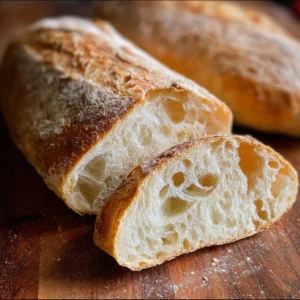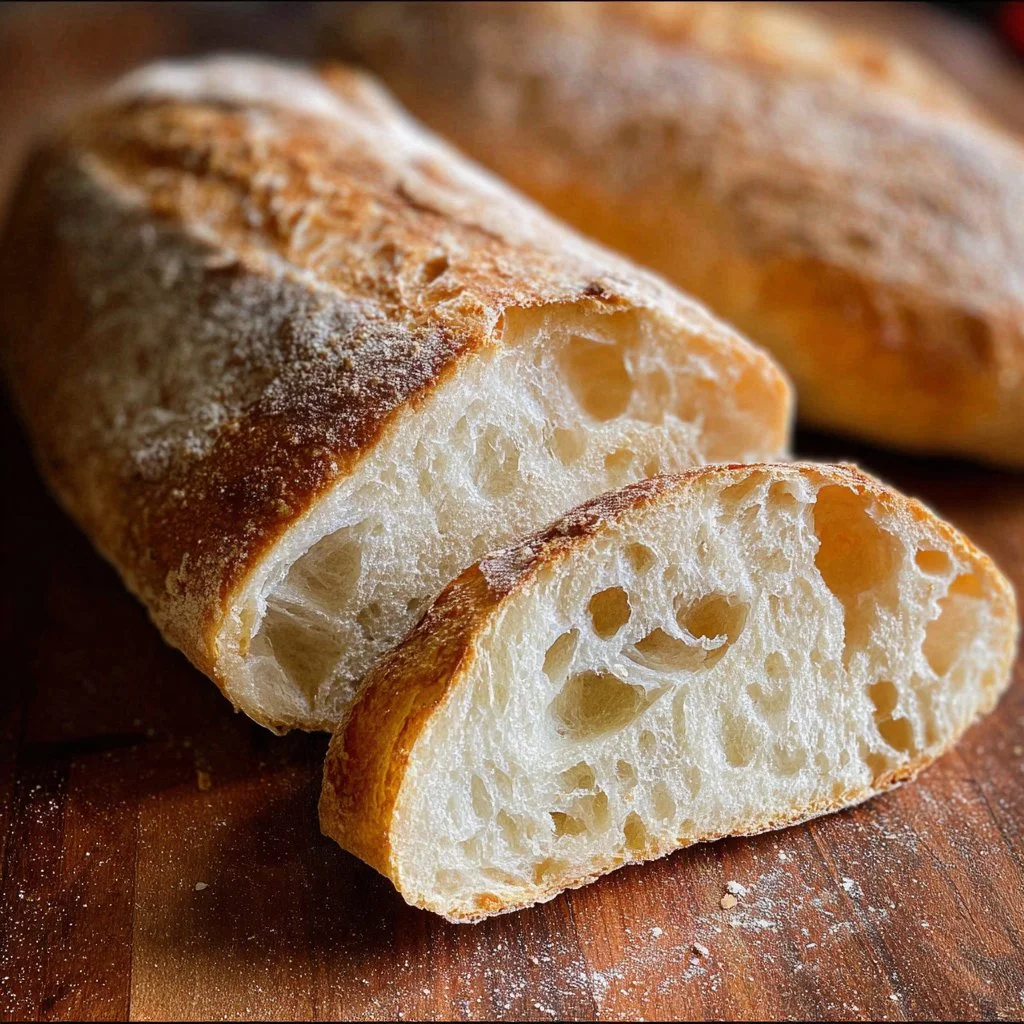Ciabatta bread is more than just a loaf; it’s an experience filled with rich flavors and delightful textures that make every bite a journey. Originating from Italy, Ciabatta translates to “slipper,” which perfectly describes its unique, rustic shape. This bread is crusty on the outside and soft on the inside, making it a perfect companion for various dishes, whether used as a sandwich base or served alongside soups and salads.
Why We Love This Ciabatta Bread Recipe
There’s something incredibly satisfying about making your own bread, and Ciabatta is no exception. This recipe is simple enough for beginners yet has a professional quality that will impress anyone. The blend of all-purpose flour, yeast, water, and just the right amount of milk results in a balanced dough that produces a beautiful loaf. The airy holes within the bread and its chewy texture allow it to capture flavors beautifully, whether you slather it with butter or pair it with dips. Additionally, the alluring aroma that fills your kitchen as the bread bakes adds an extra layer of joy to the entire process.
Ingredients for Ciabatta Bread
To craft your own Ciabatta bread, you will need the following ingredients:
For the Sponge:
- 1 cup (130 g) all-purpose flour
- 1/8 teaspoon instant yeast
- 1/2 cup (120 ml) water, at room temperature
For the Dough:
- 2 cups (260 g) all-purpose flour
- 1 1/2 teaspoons salt
- 1/2 teaspoon instant yeast
- 3/4 cup (180 ml) water, at room temperature
- 1/4 cup (60 ml) whole or 2% milk, at room temperature
How to Make Ciabatta Bread Directions
Making the Sponge: Start by combining the ingredients needed for the sponge in a medium bowl. Stir them together until a uniform mixture forms. Cover the bowl with a clean cloth or plastic wrap and let it sit at room temperature for at least 8 hours. This rest period allows the flavors to develop and the yeast to activate, setting a firm foundation for your dough.
Mixing the Dough: After your sponge has risen, it’s time to make the dough. In a stand mixer fitted with a paddle attachment, combine the sponge with the dough ingredients: flour, yeast, water, and milk. Begin mixing on low speed, which will help you form a shaggy mixture. Gradually increase the speed until you create a sticky, uniform dough.
Kneading the Dough: Switch to a dough hook and knead the mixture on medium speed for about 10 minutes until the dough becomes smooth and shiny. The gluten will develop, which is crucial for that lovely, airy texture you desire in your bread.
First Rise: Transfer the dough into a large bowl that has been lightly greased or oiled. Cover it with plastic wrap or a damp cloth and let it rise at room temperature until it has doubled in size. This will typically take about an hour, but times may vary depending on the ambient temperature.
Folding the Dough: Once risen, gently fold the dough over itself eight times. This encourages further gluten development while keeping the bubbles intact. After folding, let it rest for another 30 minutes before moving on to the shaping stage.
Preheating the Oven: Preheat your oven to 450°F (232°C). Place a baking stone on the middle rack for even heat distribution, which is essential for achieving a crispy crust.
Shaping the Dough: Transfer the dough to a well-floured surface. Divide it into two equal portions and shape each piece into a loaf. You can gently stretch and fold to create that classic slipper shape. After shaping, place the loaves on lightly floured parchment paper to prevent sticking.
Final Rest: Allow your shaped loaves to rest for 30 minutes. This is an important step as it relaxes the gluten, making your loaves easier to score and ensuring a good rise in the oven.
Preparing to Bake: Use floured fingertips to poke the loaves gently. This not only creates a decorative pattern but also helps the bread expand as it bakes. Spray the loaves lightly with water; this mimics steam in the oven and helps create a crispy crust.
Baking the Bread: Carefully slide the loaves onto the preheated baking stone in your oven. To create steam, spray the bread with water two more times during the first five minutes of baking. Bake for 22-27 minutes, or until the crust turns a beautiful golden brown and the internal temperature reaches about 210°F (99°C).
Cooling: Once baked, transfer the loaves to a cooling rack. Allow them to cool for at least 1 hour before slicing. This patience will allow the interior crumb to set, ensuring your bread doesn’t become gummy.
How to Serve Ciabatta Bread
Serving your freshly baked Ciabatta bread is one of the most exciting parts! This versatile bread pairs well with nearly anything. Consider slicing it and using it for sandwiches, where its chewy texture can hold up to toppings like fresh vegetables, cheeses, and spreads. You can also serve it alongside soups, salads, or dips. For a Mediterranean touch, drizzle some olive oil and balsamic vinegar for a delightful dipping experience.
If you want to elevate your serving game, toast it lightly to enhance its crispy exterior and serve it with garlic butter or herb-infused olive oil. You could even use Ciabatta for bruschetta by topping toasted slices with tomatoes, basil, and mozzarella for a fresh appetizer. The possibilities are endless, allowing your creativity to shine!
Expert Tips for Making Ciabatta Bread
Ingredient Quality Matters: Use high-quality flour and fresh yeast for the best results. The flavor and texture of your bread greatly depend on the ingredients you choose. Organic all-purpose flour can yield superior results.
Temperature Control: Monitor the temperature of your environment. If your kitchen is cool, your dough may take longer to rise. A slightly warmer spot can speed up the process.
Avoid Overworking: While kneading is essential, be careful not to overwork the dough after its initial rise. You want to maintain the bubbles that form for that airy texture.
Steam is Key: Steam in the oven is crucial for achieving the perfect crust. If you don’t have a baking stone, you can place a shallow pan filled with boiling water in the bottom of the oven to create steam.
How to Store Ciabatta Bread
Storing your Ciabatta bread properly is crucial to maintaining its delightful texture and flavor. If you plan to enjoy it within a few days, simply place the bread in a paper bag and store it at room temperature. For longer storage, consider freezing it. Wrap the cooled loaf tightly in plastic wrap and then in aluminum foil to prevent freezer burn. When you’re ready to enjoy it, let the bread thaw at room temperature, then pop it in a warm oven to refresh the crust.
Variations of Ciabatta Bread
While the classic Ciabatta is delightful on its own, why not experiment with variations to suit your tastes? Here are some ideas:
Herb-Infused Ciabatta: Add finely chopped herbs such as rosemary, thyme, or basil to your dough for an aromatic experience.
Olive Ciabatta: Toss in some chopped olives for a savory twist. This variation pairs beautifully with cheese or as part of a charcuterie board.
Seeded Ciabatta: Sprinkle sesame seeds or poppy seeds on top of your loaves before baking for added crunch and flavor.
Whole Wheat Ciabatta: Substitute part of the all-purpose flour with whole wheat flour for a nutty flavor and added nutrition. Just remember that the dough may be denser, so adjust hydration accordingly.
FAQs about Ciabatta Bread
What makes Ciabatta bread different from other bread? Ciabatta bread is characterized by its open crumb structure, crispy crust, and distinct shape. Its airy texture comes from high hydration in the dough, making it unique compared to denser breads.
Can I make Ciabatta bread without a stand mixer? Yes, you can mix and knead the dough by hand. It may require a bit more effort, but it’s definitely doable!
What is the best way to reheat Ciabatta bread? To achieve that freshly baked texture, wrap the bread in aluminum foil and warm it in a preheated oven at 350°F (175°C) for about 10-15 minutes.
Why is my Ciabatta bread dense? Densely baked Ciabatta may result from overworking the dough, inadequate proofing, or using the wrong flour. Ensure you follow the measurements accurately and allow for proper rising time.

Ciabatta Bread
Ingredients
- 1 cup all-purpose flour (for the sponge)
- 1/8 teaspoon instant yeast (for the sponge)
- 1/2 cup water at room temperature (for the sponge)
- 2 cups all-purpose flour (for the dough)
- 1 1/2 teaspoons salt
- 1/2 teaspoon instant yeast (for the dough)
- 3/4 cup water at room temperature (for the dough)
- 1/4 cup whole or 2% milk at room temperature
Instructions
- In a medium bowl, combine the sponge ingredients: flour, yeast, and water. Stir until uniform, cover with a cloth, and let sit at room temperature for at least 8 hours.
- In a stand mixer, combine the sponge with dough ingredients: flour, yeast, water, and milk. Mix on low speed until shaggy, then increase speed until a sticky dough forms.
- Switch to a dough hook and knead on medium speed for about 10 minutes until the dough is smooth and shiny.
- Transfer the dough to a greased bowl, cover, and let rise at room temperature until doubled in size (about 1 hour).
- Gently fold the dough over itself eight times, then let it rest for 30 minutes.
- Preheat your oven to 450°F (232°C) with a baking stone in the middle rack.
- Transfer the dough to a floured surface, divide it into two portions, and shape each into a loaf. Place on floured parchment paper.
- Let the shaped loaves rest for 30 minutes. Poke gently with floured fingers and spray with water.
- Carefully slide the loaves onto the baking stone. Spray with water twice during the first 5 minutes of baking.
- Bake for 22-27 minutes until golden brown and the internal temperature reaches about 210°F (99°C).
- Transfer to a cooling rack and let cool for at least 1 hour before slicing.
Send me this recipe!
Just enter your email below and get it sent straight to your inbox!


